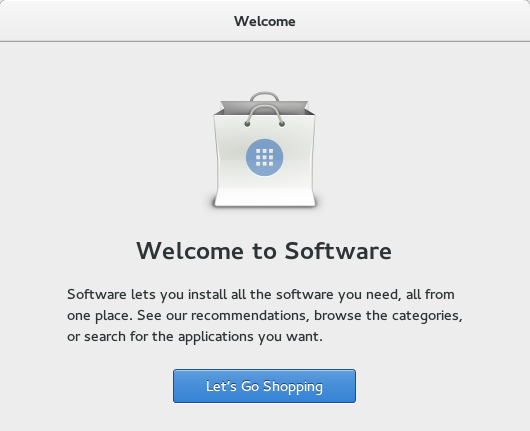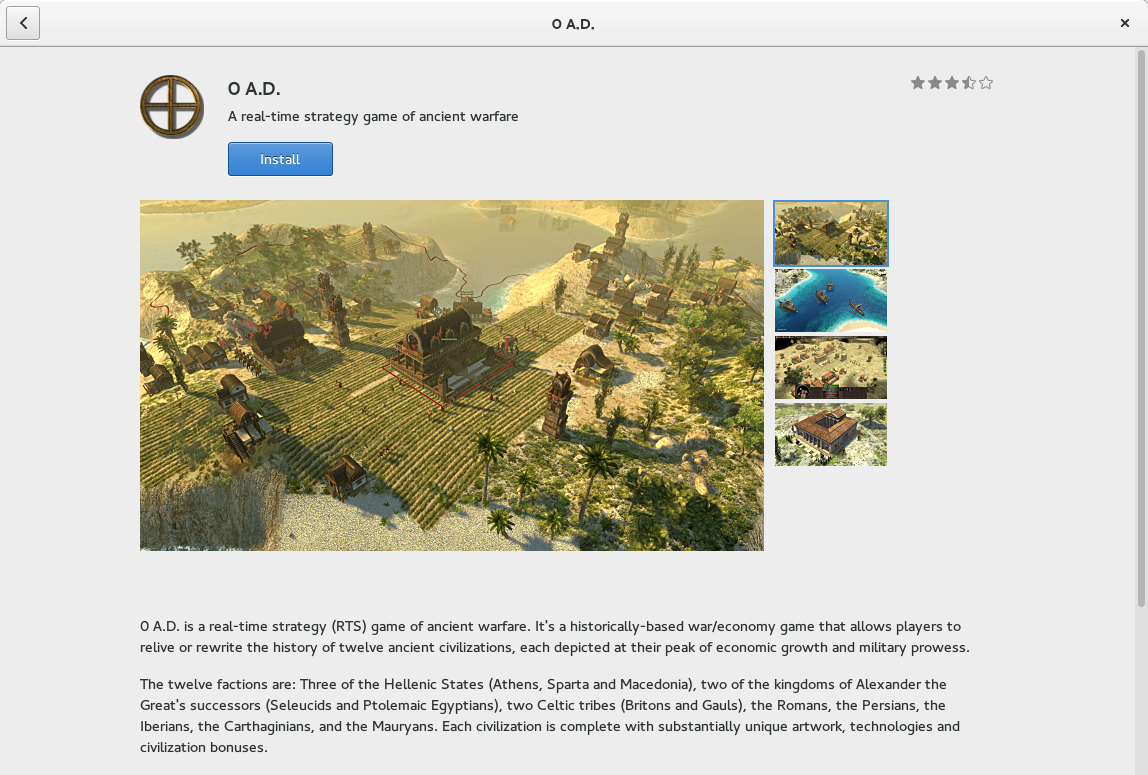We have been working hard over the past 6 months to make GNOME Software even better compared to the previous 3.12 release. Here’s a quick status update what the new 3.14 release brings.
Refined front page
Thanks to the design help from Allan Day and Lapo Calamandrei, we’ve made a number of improvements to the front page:
Improved update experience
- We’ve landed redesigns for reviewing previously installed updates, which are now shown in a separate dialog.
- It turned out that a lot of people were unhappy by too frequent update notifications, and we’ve listened: the notifications are now much less frequent. Security updates are time critical, and to make sure those get installed, GNOME Software nags daily. Other updates are now offered once a week, or you can opt to install them earlier through the GNOME Shell shutdown dialog at a convenient time, if you are rebooting / shutting down anyway.
- Update details now include the full package version when you click on an update. Again, a much requested feature by power users who want to know what they are installing.
- The updates page now shows the time when updates were last checked.
- It’s now possible to disable the background update checks altogether through a hidden setting: ‘gsettings set org.gnome.software download-updates false’
Application add-ons
No need to go back to using command line tools to install plugin for popular apps. They are all now available through GNOME Software in the app details page:
Usability testing
Jim Hall recently published the results for the usability tests he conducted as part of his Master’s program. One of the four apps tested was GNOME Software. We’ve looked through the issues pointed out and have already done a number of changes to take the usability research into account.
New first run dialog which explains what the app does:
Moved the Install / Remove buttons down from the headerbar to a more prominent position:
Support for Arch and Debian and openSUSE
It’s no longer just Fedora where GNOME Software is supported! Richard has done a lot of work this cycle to make it possible to run GNOME Software on other distros besides Fedora. Stay tuned; a number of distros are going to ship GNOME Software this fall / winter.
500 papercuts and countless bug fixes
I am exaggerating here a bit and it is actually not 500 papercuts fixed, but it is still a TON of small issues fixed, hopefully making the overall experience much nicer.
We’ve also had some very nice fixes (THANKS!!!) from people who don’t regularly work on gnome-software. To point out some:
- Find-as-your-type search by Elad Alfassa
- New icons for the high contrast accessibility theme by Andreas Nilsson
- Dogtail UI tests by Martin Simon
Fedora Workstation
GNOME Software is set to be the software installer in the upcoming Fedora 21 Workstation release and Richard and I both have been focusing a lot on making it work really well on Fedora.
- Fedora has nearly 45% of the apps now covered with appdata, thanks to the huge amount of work that Richard Hughes and Ryan Lerch and Máirín Duffy and all the rest of the Fedora contributors have put into this. But do not mistake this as a Fedora Workstation-only feature; it will also benefit Fedora’s KDE spin for having high quality app descriptions and screenshots. And it will also benefit all the rest of the distros since we’ve tried to get most of the appdata included upstream.
- A lot of improvement have landed in the stack surrounding GNOME Software. PackageKit in Fedora 21 now uses the hif backend based on the libraries from the DNF project, making the GNOME Software experience much much smoother than with the previous PackageKit yum backend. This is a huge step forward compared to what we shipped in Fedora 20.
- Once Richard’s work to include repository metadata on the Workstation install media lands, it should make the first launch experience much better by removing the need to wait while the metadata is downloaded.
If you have free time and want to help out GNOME Software, install Fedora 21 Alpha Workstation and give GNOME Software a try and report any bugs you can find. All feedback and bug reports are invaluable and highly appreciated.
Thanks everyone and hope you’ll enjoy GNOME Software 3.14!




Wait, does that mean we can update before shutting down? No reboot required? Or at least, one reboot to the updater, and then it shuts down completely?
Because the most annoying thing about offline updates is that you must reboot, and I have no intention of doing so in the middle of the day, and it’s a waste of time at the end of the day.
Sorry, I should have expanded on this a bit more.
I completely agree with what you are saying that notifications asking to reboot in the middle of the day while you are doing something else are uncalled for. So those are now tuned down.
Instead, we now have the option to install updates from the gnome-shell shutdown dialog. Either when powering off or rebooting, both work. When you are done for the day, tick “Install pending software updates” and click Power Off and walk away and it will install updates and power off the computer when done. No need to babysit the updates any more.
Now where have I seen that “feature” before? 😉
Meanwhile, Apper can update your system just fine without rebooting. :-p
Good work, i love gnome <3
I’m quite happy so far on arch with 3.14 and gnome software look promising also on it but I would like a add one comment about about that statement.
“It turned out that a lot of people were unhappy by too frequent update notifications, and we’ve listened: the notifications are now much less frequent. Security updates are time critical, and to make sure those get installed, GNOME Software nags daily. Other updates are now offered once a week, or you can opt to install them earlier through the GNOME”
yes and because of gnome’s notification structure, really wonder who and why did such a thing like a pressuring bottom of screen spawn notification area and tear apart screen. You just need to put one notification area icon to the top right side where sit next to connection sound icons etc. and permanently store all notifications there such as receiving messages while playing full screen games or doing something, so end-user can see all counted notifications when clicked on that notification icon like in osx.
Hopefully we’ll get better notifications soon when http://afaikblog.wordpress.com/2014/06/18/a-notifications-update/ lands.
Ah thanks for that, I was aware of that. I wish to say good luck on it and thanks again for the hard work done so far 🙂
Fedora has nearly 45% of the apps now covered with appdata, thanks to the huge amount of work that Richard Hughes and Ryan Lerch and Máirín Duffy and all the rest of the Fedora contributors have put into this. But do not mistake this as a Fedora Workstation-only feature; it will also benefit Fedora’s KDE spin for having high quality app descriptions and screenshots.
But the AppData for the KDE applications actually comes from the upstream KDE community (mostly submitted by Matthias Klumpp of upstream PackageKit fame), not from the people you listed. 🙂
What strikes me as odd in the screenshots is the caption of the “Let’s Go Shopping” button. At least to me, the wording implies that you would be asking the user to give you money, which is actually not the case.
As much as I like the general design of Gnome Software, I basically stopped using it as it requires me to reboot my machine at nearly every update just to update the software. Usually I just keep my PC running or putting it in suspend-to-ram, but I certainly don’t like it rebooting more than once a month. Interestingly, doing the update with yum on the command line does not force me to reboot.
Yes, require an reboot for updates are just bad… else it has some pretty damn good improvements.
So, do apps without appdata show up? at least just a title to show that I have access to install it? because honestly, a GUI software installers that cannot fallback at least to the mere name of a package if appdata is not present is basically useless to me, since two thirds of my software comes from non Fedora repositories.
Still waiting for pacman support.
Can’t wait for this feature though.
Pingback: Links 24/9/2014: GNOME 3.14 Released, Bash Has a Bug | Techrights
Regarding notifications, notification at the bottom of the screen have one very big advantage for me: they are magic.
Actually, I’m using Gnome at home and at work. Gnome is great because this is the first DE which let me be contactable without constantly distracting me.
This is real magic because if I’m focused on work, I will miss notifications and chat. And that’s great: I’m more productive and I can actually leave earlier on evenings! 🙂 On the contrary, if I’m not focused on one task or need a break, then I can either notice a new notification or look for old ones.
This is why the current notification system is magic. If you don’t want ti miss notifications, I guess you can use an extension to do just that.
Note that I am not saying that I’m not frustrated by the current system at time. I’m just a bit worried that by putting notifications at the top of the screen, I would lose this magic.
Cheers,
GG
Pingback: What's new in GNOME Software 3.14 | Kalev Lember - GNOME Blogs | reconWarehousereconWarehouse
Kalev, are you Estonian?
I am indeed.
Does that mean GNOME Software will work fine on distros such as Ubuntu GNOME or elementary OS?
Pingback: Fedora Workstation Progress Report (Wayland and more) | Christian Schaller
Why nag me? Why not just install them?
Why should I have to click a button every so often, just so that my computer continues to work properly?
How to install Gnome Software on Ubuntu 14.10???
Thanks….
I think an important note here in all these comments is simply to have options for updates. Just have a non-hidden option to be able to choose the frequency of update checks ( none ( or on-demand ), daily, weekly, monthly ) would be the overall best solution.
I haven’t tried Gnome 3.14 yet, despite being an Arch user, but right now I’m just waiting for OpenSUSE 13.2 to come out next week.